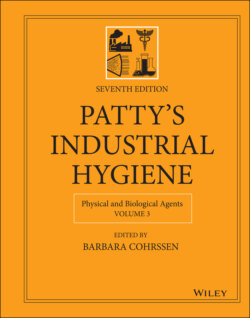Читать книгу Patty's Industrial Hygiene, Physical and Biological Agents - Группа авторов - Страница 47
8.2 Internal Radiation
ОглавлениеIn the context of radiation safety, the radiation dose from an internally deposited radionuclide is no different from the same dose absorbed from external radiation. Therefore, it must be emphasized that a millirem of dose is a millirem, regardless of whether it was delivered from an internally deposited radionuclide or from an external source.
Radioactive substances, such as other noxious agents with which the industrial hygienist deals, may gain entry into the body through four pathways:
1 Inhalation. By breathing radioactive aerosols or gases.
2 Ingestion. By drinking contaminated water, eating contaminated food, or tactilely transferring radioactivity into the mouth.
3 Absorption. By transcutaneous absorption.
4 Injection. Through wounds penetrating the skin.
Measures to prevent internal exposure therefore are designed to either block a portal of entry or to interrupt the transmission pathway. These preventive measures can be effected either at the source by enclosing and confining it, through environmental control by ventilation, or with the use of protective clothing and respiratory protective devices. It should be noted that these measures are the same as those employed in the practice of industrial hygiene in a nonradiation environment. However, because of the nature of radiation and radioactive materials, the degree of control required for radiation safety greatly exceeds the requirements for chemical safety. For example, the permissible exposure level (PEL) for inorganic mercury is listed as 0.1 mg m−3. For a commonly used radioisotope of mercury, 203Hg, the NRC's limit of 4 × 10−7 μCi cm−3 corresponds to a mass concentration of 3 × 10−8 mg m−3. A consideration when dealing with radioactive materials is whether or not to use a respirator. This question arises when a worker is exposed simultaneously to external radiation and to radioactive aerosols. Respirator use can offer protection against airborne radioactivity, thereby limiting the worker's internal dose. However, wearing a respirator decreases the worker's efficiency, increases the time necessary to complete the job, and thus increases his external dose. The decision regarding the use of a respirator depends on the effect of the respirator on the worker's total dose, the sum of the external and the internal doses from the inhaled radioactivity.
